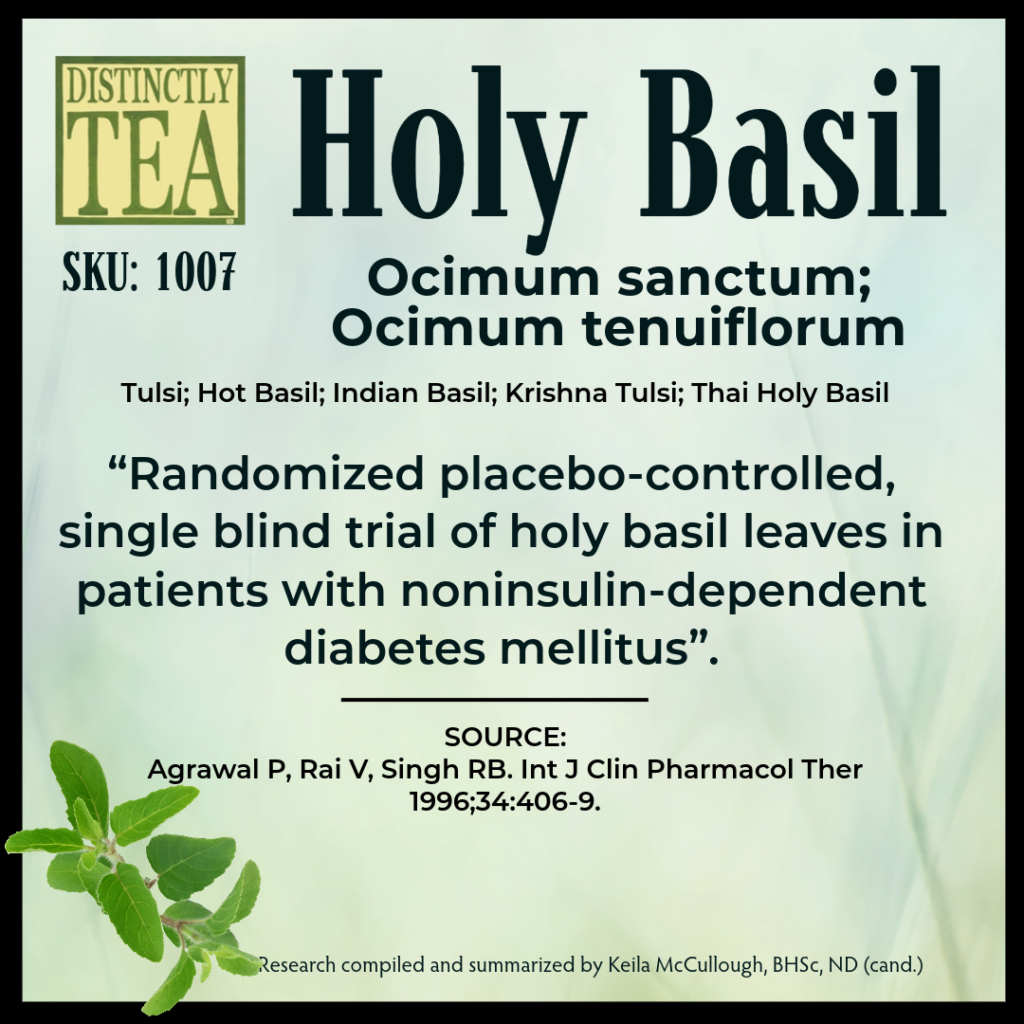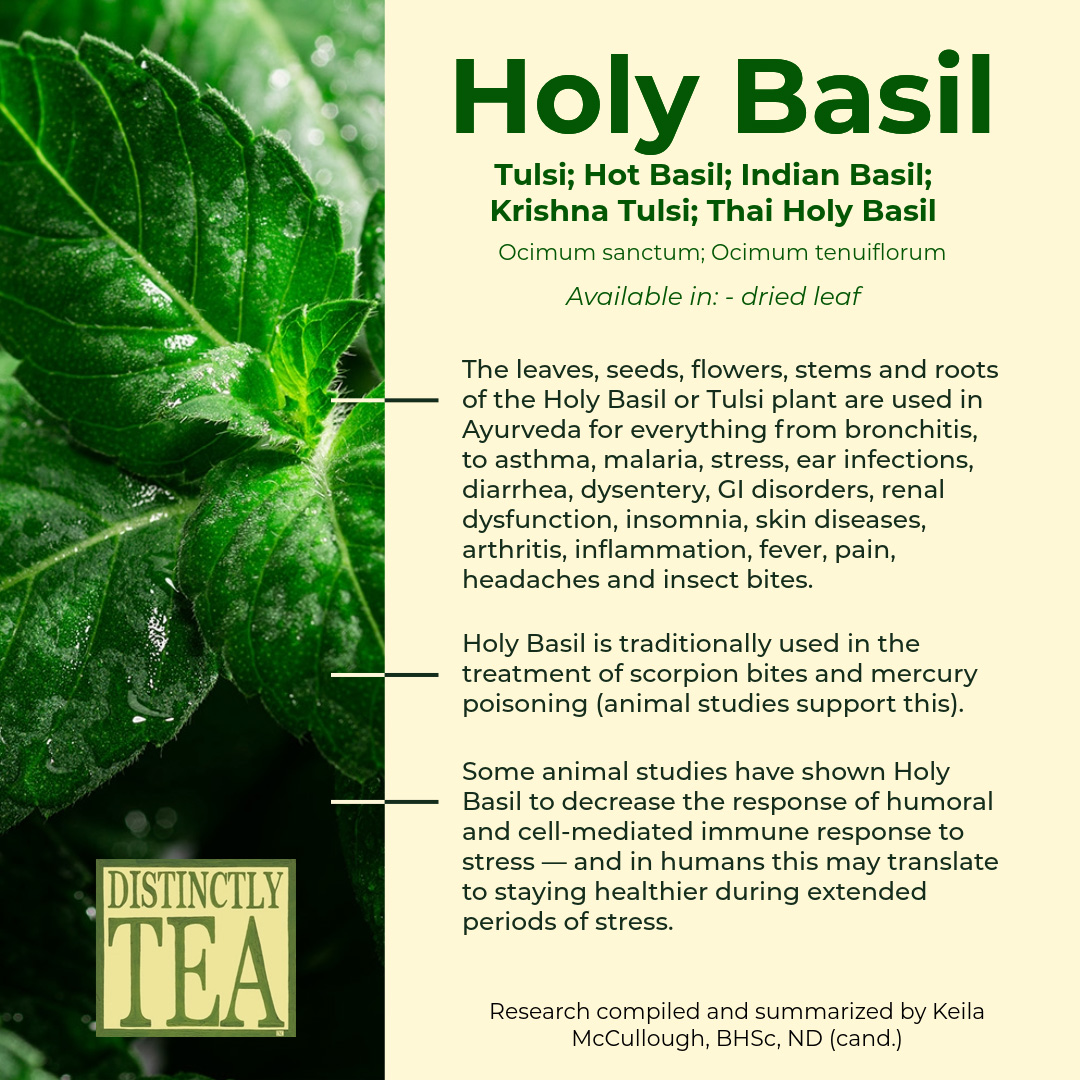Holy Healer LaPacho Blend
A combination of Lapacho bark and Holy Basil with a pleasant lemon taste. Item No: 1014-500
Shop Tea Containing Holy Basil
Holy Basil
Tulsi; Hot Basil; Indian Basil;
Krishna Tulsi; Thai Holy Basil
Ocimum sanctum;
Ocimum tenuiflorum

Holy Basil, also known as “The Incomparable One”, is a sacred plant of the Hindu tradition and is said to represent Vishnupriya, the wife of the deity Vishnu. Thus in ceremonies honoring Vishnu, it is honored also. So important to the culture is this herb that it is often grown around the home and at the entrance of the holy temples in India. It is mentioned as early as 1500 B.C. in the Rig Veda, Puranas and in the Ayurvedic medical texts, as well as the Charaka Samhita written around 2nd Century B.C. Used historically for a very diverse range of conditions, its adaptogenic properties are similar to that of Siberian Ginseng and Asian Ginseng. It is also becoming quite popular in the West due to its cortisol lowering effects—thus it is potentially very useful for stressed out, busy people.
The leaves, seeds, flowers, stems and roots of the Holy Basil or Tulsi plant are used in Ayurveda for everything from bronchitis, to asthma, malaria, stress, ear infections, diarrhea, dysentery, GI disorders, renal dysfunction, insomnia, skin diseases, arthritis, inflammation, fever, pain, headaches and insect bites. Active constituents include saponins, tannins, flavonoids, and triterpinoids while the leaves contain the essential oils eugenol, methyl eugenol and caryophyllene. The seeds also contain the fatty acids palmitic acid, linoleic acid, linolenic acid, stearic and acid. Linoleic acid and the essential oils (especially eugenol) may be involved in inhibiting cyclooxygenase and lipooxygenase — major mediators of the inflammatory pathway, thus helpful in reducing inflammation and in the treatment of arthritis. These constituents are said to have antiemetic, anticancer, hypoglycemic, hypotensive, sedative, antimicrobial, antiviral, anti-inflammatory, antipyretic, analgesic, and antiulcer properties — lending credibility to the diverse range of traditional uses of Holy Basil. Several animal studies support these the anti-pyretic, analgesic, immunomodulatory effects as well. Holy Basil shows promise in the treatment of fungal infections such as candidosis and may work synergistically with the most common anti-fungal medications. Interestingly, Holy Basil is often compared to Ginseng and is said to be the Ayruvedic equivalent to the root. Some animal studies have shown Holy Basil to decrease the response of humoral and cell-mediated immune response to stress — and in humans this may translate to staying healthier during extended periods of stress.
Holy Basil is traditionally used in the treatment of scorpion bites and mercury poisoning (animal studies support this). There is also evidence of some anthelmintic activity. The seed oil Holy Basil may also be protective against the effects of aspirin (there is a risk for gastric bleeding and Holy Basil reduces the risk), indomethacin, alcohol, and stress-induced ulceration. Bleeding time, however, may be prolonged because platelet aggregation can be affected when taking Holy Basil for prolonged periods of time (although research suggests that Holy Basil may be used safely for up to four weeks with minimal risk of adverse events or side effects). Because of its sedating effects on the central nervous system, there is quite a bit of historical and research evidence to support the use of Holy Basil as an anticonvulsive agent. It is supposed to reduce the duration and intensity of seizures in animal electro-stimulation and chemically induced seizure trials. Some studies show comparable effects to phenytoin, a commonly used antiepileptic medication.
.
To prepare a cup of Holy Basil tea, pour one cup of boiling water over 2 tsp of crushed leaves, let steep 2-5 minutes, drinking 1-4 times a day. The tea can be sweetened with honey, or made with cinnamon, cardamom and cloves for a more traditional Tulsi tea. Either way, the tea makes a nice after dinner drink to aid digestion.
ALTHOUGH SIDE EFFECTS ARE RARE AND HOLY BASIL IS NORMALLY CONSIDERED SAFE FOR ORAL CONSUMPTION FOR UP TO FOUR WEEKS, SOME ANIMAL STUDIES SUGGEST THAT IN SOME CASES IT MAY REDUCE SPERM COUNTS AND FERTILITY. EXERCISE CAUTION WHEN COMBINING WITH HERBS OR MEDICATIONS THAT HAVE ANTI-PLATELET EFFECTS AS THIS MAY INCREASE THE RISK OF BLEEDING AND PROLONG BLEEDING TIME. THESE HERBS INCLUDE ANGELICA, CLOVE, DANSHEN, GINGER, GARLIC, GINKGO AND PANAX GINSENG. MEDICATIONS INCLUDE WARFARIN, ASPIRIN, HEPARIN, CLOPIDOGREL, DALTEPARIN AND ENOXAPARIN. THEORETICALLY, HOLY BASIL MAY INTENSIFY THE SEDATIVE EFFECTS OF CERTAIN HERBS AND MEDICATIONS SUCH AS PENTOBABITOLS.
For educational purposes only. This information has not been evaluated by the Canadian Food & Drug Administration.
This information is not intended to diagnose, treat, cure or prevent any disease. www.distinctlytea.com 519-578-2010 distinctlytea@rogers.com
Research compiled and summarized by Keila McCullough BHSc, ND (cand.) Distinctly Tea Inc.
Sources:
“Anticandidal effect of Ocimum sanctum essential oil and its synergy with fluconazole and ketoconazole”. Amber K, Aijaz A, Immaculata X, Luqman KA, Nikhat M. Phytomedicine. 2010 Apr 6. [abstract].
“Anticonvulsant potential of holy basil, Ocimum sanctum Linn. and its cultures”. Jaggi RK, Madaan R, Singh B. Indian J Exp Biol 2003;41:1329-33.
“Antioxidant and cyclooxygenase inhibitory phenolic compounds from Ocimum sanctum Linn”. Kelm MA, Nair MG, Strasburg GM, DeWitt DL. Phytomedicine 2000;7:7-13.
“Effect of Ocimum sanctum fixed oil on blood pressure, blood clotting time and pentobarbitone-induced sleeping time”. Singh S, Rehan HM, Majumdar DK. J Ethnopharmacol 2001;78:139-43.
“Effect of Ocimum sanctum fixed oil on vascular permeability and leucocytes migration”. Singh S, Majumdar DK. Indian J Exp Biol 1999 37:1136-8.
‘
“Evaluation of the gastric antiulcer activity of fixed oil of Ocimum sanctum (Holy Basil)”. Singh S, Majumdar DK. J Ethnopharmacol 1999;65:13-9.
“Evaluation of immunomodulatory potential of Ocimum sanctum seed oil and its possible mechanism of action”. Mediratta PK, Sharma KK, Singh S. J Ethnopharmacol 2002;80:15-20.
“Holy Basil—history”. Plant Cultures—Exploring Plants and People. http://www.plantcultures.org/plants/ holy_basil_history.html
“Holy Basil” Monograph. Natural Medicines Comprehensive Database. http://www.naturaldatabase.com/
“Randomized placebo-controlled, single blind trial of holy basil leaves in patients with noninsulin-dependent diabetes mellitus”. Agrawal P, Rai V, Singh RB. Int J Clin Pharmacol Ther 1996;34:406-9.
“Ocimum sanctum aqueous leaf extract provides protection against mercury induced toxicity in Swiss albino mice”. Sharma MK, Kumar M, Kumar A. Indian J Exp Biol 2002;40:1079-82.
“Therapeutic uses of Ocimum sanctum Linn (Tulsi) with a note on eugenol and its pharmacological actions: a short review”. Prakash P, Gupta N. Indian J Physiol Pharmacol. 2005 Apr;49(2):125-31.
Research compiled and summarized by Keila McCullough BHSc, ND (cand.)


0 Comments